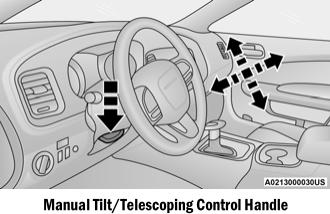Dodge Charger: STEERING WHEEL / Heated Steering Wheel — If Equipped
The steering wheel contains a heating element that helps warm your hands in cold weather. The heated steering wheel has only one temperature setting. Once the heated steering wheel has been turned on, it will stay on for an average of 80 minutes before automatically shutting off. This time will vary based on environmental temperatures. The heated steering wheel can shut off early or may not turn on when the steering wheel is already warm.
The heated steering wheel control button is located within the Uconnect system. You can gain access to the control button through the climate screen or the controls screen.
- Press the heated steering wheel button once to turn the heating element on.
- Press the heated steering wheel button a second time to turn the heating element off.
NOTE:
The engine must be running for the heated steering wheel to operate.
For information on use with the Remote Start system.
WARNING!
- Persons who are unable to feel pain to the skin because of advanced age, chronic illness, diabetes, spinal cord injury, medica- tion, alcohol use, exhaustion, or other phys- ical conditions must exercise care when using the steering wheel heater. It may cause burns even at low temperatures, especially if used for long periods.
- Do not place anything on the steering wheel that insulates against heat, such as a blanket or steering wheel covers of any type and material. This may cause the steering wheel heater to overheat.
 Power Tilt/Telescoping Steering Column — If Equipped
Power Tilt/Telescoping Steering Column — If Equipped
This feature allows you to tilt the steering column upward or downward. It also
allows you to lengthen or shorten the steering column. The power tilt/telescoping
steering column control is located below the multifunction lever on the steering
column...
Other information:
Dodge Charger 2011-2025 Owner's Manual: Automatic Window Features
Auto-Down Feature The driver and front passenger door power window switches have an Auto-Down feature. Push the window switch down to the second detent, release, and the window will go down automatically. To stop the window from going all the way down during the Auto-Down operation, pull up or push down on the switch briefly...
Dodge Charger 2011-2025 Owner's Manual: Windshield Wiper Operation
Rotate the end of the multifunction lever to the first detent, past the intermittent settings for low-speed wiper operation, or to the second detent past the intermittent settings for high-speed wiper operation. CAUTION! Always remove any buildup of snow that prevents the windshield wiper blades from returning to the “park” position...
Categories
- Manuals Home
- Dodge Charger Owners Manual
- Dodge Charger Service Manual
- Sport Mode
- High/Low Beam Switch, Automatic High Beam — If Equipped
- USB/AUX Control
- New on site
- Most important about car
Manual Tilt/Telescoping Steering Column — If Equipped
This feature allows you to tilt the steering column upward or downward. It also allows you to lengthen or shorten the steering column. The tilt/telescoping control is located below the steering wheel at the end of the steering column.


